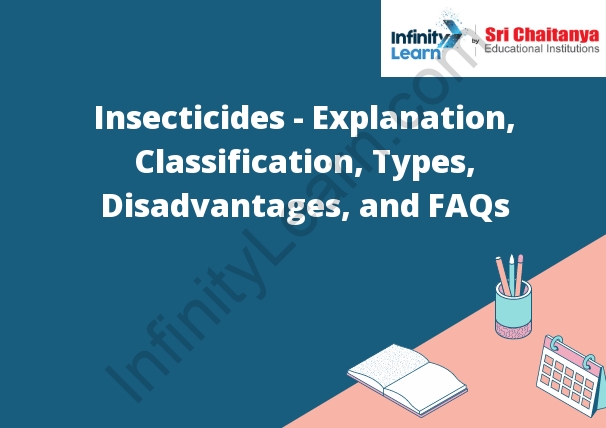Table of Contents
An Introduction to Insecticides
Insecticides – Explanation: Insecticides are organic or synthetic chemicals that kill insects. They are used to protect crops from being eaten by pests, to control insects that can spread disease, and to kill insects that are pests in homes and gardens.
There are many different types of insecticides. Some are sprayed on crops or plants, some are used to treat soil, and others are used as baits or traps. Some insecticides are available to consumers for use in the home and garden, while others are only available to licensed professionals.

What are Insecticides?
Insecticides are chemicals that are used to kill insects. They are used to protect crops from being eaten by insects, to protect people and animals from being bitten by insects, and to control insect pests in homes, gardens, and other areas.
Classification of Insecticides
Insecticides can be classified on the basis of their chemical structure, mode of action, or target organism.
- Organophosphate insecticides are a group of insecticides that contain the phosphorus-carbon bond. They are effective against a wide range of pests, but can be toxic to humans and other animals.
- Pyrethroid insecticides are a group of insecticides that contain the carbon-chlorine bond. They are also effective against a wide range of pests, and are less toxic to humans and other animals than organophosphate insecticides.
- Carbamate insecticides are a group of insecticides that contain the carbon-nitrogen bond. They are also effective against a wide range of pests, and are less toxic to humans and other animals than organophosphate and pyrethroid insecticides.
Types of Insecticides
Insecticides are chemicals used to kill or control insects. They can be divided into three main types: synthetic organic insecticides, natural organic insecticides, and inorganic insecticides.
- Synthetic organic insecticides are chemicals that are made from organic (carbon-containing) molecules. They include the insecticides DDT and malathion.
- Natural organic insecticides are chemicals that are found in nature. They include the insecticide pyrethrum, which is extracted from the flowers of the chrysanthemum plant.
- Inorganic insecticides are chemicals that are not made from organic molecules. They include the insecticides arsenic and sulfur.
Insecticides Classification based on Their Chemical Nature
Insecticides are classified according to their chemical nature. The two main classes of insecticides are synthetic organic insecticides and natural organic insecticides.
1. Synthetic organic insecticides
Synthetic organic insecticides are made from petrochemicals. They are highly effective at killing insects, but they also pose a risk to human health and the environment. Examples of synthetic organic insecticides include DDT, malathion, and carbaryl.
2. Natural organic insecticides
Natural organic insecticides are made from plant extracts. They are less effective than synthetic organic insecticides, but they are less harmful to humans and the environment. Examples of natural organic insecticides include pyrethrum and rotenone.
Synthetic Insecticides and Natural Insecticides
There are many different types of synthetic and natural insecticides. Synthetic insecticides are man-made, while natural insecticides are derived from plants or animals. Synthetic insecticides are often more potent than natural insecticides, but they can also be more harmful to the environment. Natural insecticides are generally less harmful to the environment, but they may not be as effective as synthetic insecticides.
Organochlorides
- Organochlorides are a class of chemical compounds that contain carbon and chlorine. They are widely used in industry and agriculture, and include some of the most toxic chemicals known.
- Some organochlorides, such as DDT, were once widely used as pesticides, but their use has been phased out due to their environmental and health hazards. Others, such as PCBs, have been widely used in industry, but are now being phased out due to their toxicity and persistence in the environment.
- Organochlorides can cause a variety of health problems, including cancer, reproductive problems, and nerve damage. They are also very persistent in the environment, and can accumulate in the food chain.
Carbamates and Organophosphates
- Organophosphates and carbamates are both types of pesticides. Carbamates are less toxic than organophosphates, but both types of pesticides can be harmful to humans.
- Organophosphates are effective at killing pests, but they can also be harmful to humans. Organophosphates work by disrupting the nervous system, which can lead to seizures, respiratory problems, and even death.
- Carbamates are less toxic than organophosphates, but they can still be harmful to humans. Carbamates work by inhibiting the enzyme that allows pests to break down sugar, which can kill the pests or make them more susceptible to other pesticides.
Pyrethroids
- Pyrethroids are a class of insecticides that share a common chemical structure. They are effective against a wide variety of insects, including mosquitoes, flies, fleas, and ticks.
- Pyrethroids work by disrupting the normal functioning of an insect’s nervous system. This leads to the insect’s death.
- Pyrethroids are generally considered safe for humans and animals. However, they can cause skin irritation in some people.
Disadvantages of Insecticides
- Insecticides can be harmful to the environment if used improperly. They can also be harmful to humans and other animals if ingested.
- Insecticides are chemicals that are used to kill insects. They are used in agriculture to protect crops from being eaten by insects, and in homes to protect against insects that can spread diseases.
- There are several disadvantages to using insecticides. First, they can kill beneficial insects along with the pests. This can disrupt the natural balance of the ecosystem and lead to the proliferation of pests. Second, they can be harmful to humans and animals. They can cause skin rashes, respiratory problems, and even death. Third, they can be expensive to use. And fourth, they can be ineffective in controlling pests.
- In conclusion, there are several disadvantages to using insecticides. They can kill beneficial insects, be harmful to humans and animals, be expensive to use, and be ineffective in controlling pests.









